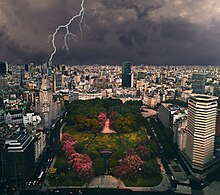Plaza San Martín (Buenos Aires)

Plaza San Martín (
Santa Fe Avenue (S), and Leandro Alem Av. (E). Its coordinates are 34°35′42″S 58°22′32″W / 34.59500°S 58.37556°W
.
History
Ombú
treeA succession of colonial
eponymous in Argentina after his death in 1850. Accordingly, French sculptor Louis-Joseph Daumas
was commissioned in 1862 to create an equestrian statue of the hero of the Wars for Independence and the square was renamed in his honor in 1878, upon the hundredth anniversary of his birth.



Following remodeling works by British architect Edward Taylor and Argentine architect José Canale, the fort, bullring and other buildings were demolished in 1883 by order of Mayor
Neogothic Haedo Palace
(today the offices of the National Parks Administration).
The park was the site in 1909 of the inaugural of both the first premier hotel in Argentina (the
1889 World's Fair in Paris was enlisted; structurally inadequate, the pavilion was demolished in 1932, however. Plaza San Martín and its surroundings acquired their current physiognomy in 1936, when Charles Thays' son, Carlos León Thays, designed the esplanade surrounding the monument and when the 33-story Art Deco Kavanagh Building was completed. Though the surrounding area has since seen much of its older architecture replaced by high-rises (notably the 1975 Pirelli building), the plaza has remained timeless. Its western section was separated to make way for a rerouting of Maipú Street in 1972; but President Néstor Kirchner
ordered the change reverted in 2004, in response to long-standing appeals by neighbours and friends of the park.
Events
In spring 2009 an exhibition of the "United Buddy Bears" was held in the park, for the first on the American continent. The exhibition consisted of more than 140 bear sculptures, each two metres high and designed by a different artist.
